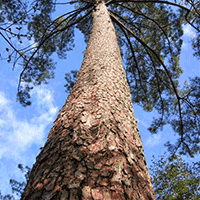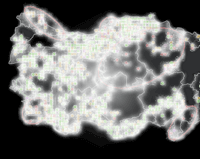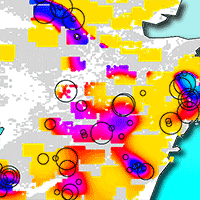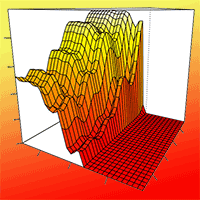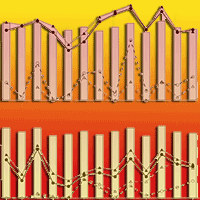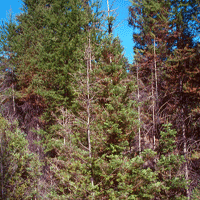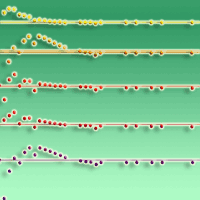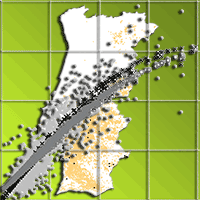
Spatio-temporal modelling of forest monitoring data: modelling German tree defoliation data collected between 1989 and 2015 for trend estimation and survey grid examination using GAMMs
Nadine Eickenscheidt (1-2) , Nicole H Augustin (3), Nicole Wellbrock (1)
iForest - Biogeosciences and Forestry, Volume 12, Issue 4, Pages 338-348 (2019)
doi: https://doi.org/10.3832/ifor2932-012
Published: Jul 05, 2019 - Copyright © 2019 SISEF
Research Articles
Abstract
Spatio-temporal modelling of tree defoliation data from the German forest condition survey is statistically challenging, particularly due to irregular grids. In the present study, generalized additive mixed models (GAMMs) were used to estimate the spatio-temporal trends in defoliation of the main tree species spruce, pine, beech and oak from 1989 to 2015 and to examine the suitability of different monitoring grid resolutions (standard 16 × 16 km grid and denser grids). Although data has been collected since 1989, this is the first time spatio-temporal modelling for all of Germany has been carried out. GAMMs proved to be a statistically sound and highly flexible choice for spatio-temporal modelling of defoliation data. In addition to the space-time component, stand age showed a significant effect on defoliation. The mean age and the species-specific relation between defoliation and age determined the general level of defoliation. However, further investigations are necessary in order to understand what is behind the age effect. Adjustment for stand age was carried out for identifying hotspots of high defoliation that are not merely the result of the age effect. Fluctuations in defoliation were most likely related to weather conditions. South-western Germany has emerged as the region with the highest defoliation since the drought year 2003. This region was characterized by the strongest water deficits in 2003 compared to the long-term reference period (1961-1990). Furthermore, the spatio-temporal model was used to carry out a simulation study to compare different survey grid resolutions in terms of prediction error. The model-based approach for grid analysis turned out to be appropriate for the given data and sample design. The grid analysis indicated that an 8 × 8 km grid instead of the standard 16 × 16 km grid is necessary for spatio-temporal trend estimation and for detecting hotspots in defoliation in space and time, especially regarding oaks.
Keywords
Age Effect, Drought Stress, Forest Condition Survey, Generalized Additive Mixed Models, Grid Examination, Spatio-temporal Model, Survey Design, Tensor Product Smooth
Authors’ Info
Authors’ address
Nicole Wellbrock
Thünen Institute of Forest Ecosystems, Alfred-Möller-Strasse 1, 16225 Eberswalde (Germany)
State Agency for Nature, Environment and Consumer Protection of North Rhine-Westphalia, Leibnizstrasse 10, 45659 Recklinghausen (Germany)
University of Bath, Claverton Down, Bath BA2 7AY (United Kingdom)
Corresponding author
Paper Info
Citation
Eickenscheidt N, Augustin NH, Wellbrock N (2019). Spatio-temporal modelling of forest monitoring data: modelling German tree defoliation data collected between 1989 and 2015 for trend estimation and survey grid examination using GAMMs. iForest 12: 338-348. - doi: 10.3832/ifor2932-012
Academic Editor
Matteo Garbarino
Paper history
Received: Jul 25, 2018
Accepted: Apr 10, 2019
First online: Jul 05, 2019
Publication Date: Aug 31, 2019
Publication Time: 2.87 months
Copyright Information
© SISEF - The Italian Society of Silviculture and Forest Ecology 2019
Open Access
This article is distributed under the terms of the Creative Commons Attribution-Non Commercial 4.0 International (https://creativecommons.org/licenses/by-nc/4.0/), which permits unrestricted use, distribution, and reproduction in any medium, provided you give appropriate credit to the original author(s) and the source, provide a link to the Creative Commons license, and indicate if changes were made.
Web Metrics
Breakdown by View Type
Article Usage
Total Article Views: 43176
(from publication date up to now)
Breakdown by View Type
HTML Page Views: 35323
Abstract Page Views: 3905
PDF Downloads: 3149
Citation/Reference Downloads: 18
XML Downloads: 781
Web Metrics
Days since publication: 2374
Overall contacts: 43176
Avg. contacts per week: 127.31
Citation Metrics
Article Citations
Article citations are based on data periodically collected from the Clarivate Web of Science web site
(last update: Mar 2025)
Total number of cites (since 2019): 11
Average cites per year: 1.57
Publication Metrics
by Dimensions ©
Articles citing this article
List of the papers citing this article based on CrossRef Cited-by.
References
Auswirkung der Trockenheit 2003 auf Waldzustand und Waldbau [Effect of the drought 2003 on crown condition and forestry]. BFH, Eberswalde, Germany, pp. 109. [in German]
Gscholar
Ergebnisse der Waldzustandserhebung 2016 [Results of the forest condition survey 2016]. BMEL, Bonn, Germany, pp. 50. [in German]
Gscholar
Part IV: visual assessment of crown condition and damaging agents. In: “Manual on Methods and Criteria For Harmonized Sampling, Assessment, Monitoring and Analysis of the Effects of Air Pollution on Forests” (UNECE ICP Forests Programme Co-ordinating Centre ed). Thünen Institute of Forest Ecosystems, Eberswalde, Germany, pp. 54.
Online | Gscholar
Chapter 11 - Spatial response patterns in biotic reactions of forest trees and their associations with environmental variables in Germany. In: “Status and dynamics of forest soils in an ecosystem context” (Wellbrock N, Bolte A eds). Ecological Studies. [in press]
Gscholar
Basic design principles for the ICP forests monitoring networks. Manual Part II. In: “Manual on Methods and Criteria For Harmonized Sampling, Assessment, Monitoring and Analysis of the Effects of Air Pollution on Forests” (UNECE ICP Forests Programme Co-ordinating Centre ed). vTI - Institute for World Forestry, Hamburg, Germany, pp. 22.
Gscholar
Plot-scale modelling to detect size, extent, and correlates of changes in tree defoliation in French high forests. Forest Ecology and Management 311: 56-69.
CrossRef | Gscholar
Climate change impacts, adaptive capacity, and vulnerability of European forest ecosystems. Forest Ecology and Management 259 (4): 698-709.
CrossRef | Gscholar
Waldzustandsbericht 2015 [Forest condition report 2015]. Ministerium für Umwelt, Landwirtschaft, Ernährung, Weinbau und Forsten, Mainz, Germany, pp. 106. [in German]
Gscholar
Mixed-effects models in S and S-PLUS. Springer, New York, USA, pp. 548.
Gscholar
Growth and yield of mixed versus pure stands of Scots pine (Pinus sylvestris L.) and European beech (Fagus sylvatica L.) analysed along a productivity gradient through Europe. European Journal of Forest Research 134 (5): 927-947.
CrossRef | Gscholar
Repräsentanz des europäischen 10 × 16 km-Erhebungsnetzes für Aussagen zum deutschen Waldbodenzustand [Representativity of the European 10 × 16 km grid regarding conclusions about the German forest soil condition]. BFH, Hamburg, Germany, pp. 57. [in German]
Gscholar
Integrierende Auswertung bundesweiter Waldzustandsdaten [Integrative evaluation of the German forest condition data]. BFH, Eberswalde, Germany, pp. 141. [in German]
Gscholar
Stichprobentheoretische Analyse der Waldschadenserhebung in Niedersachsen [Sampling theory-based analysis of the forest condition survey of Lower Saxony]. AFJZ 169 (3): 47-52. [in German]
Gscholar
Integrative studies on forest ecosystem conditions. UNECE, EC and Flemish Community, Geneva, Switzerland, Brussels and Gent, Belgium, pp. 88.
Gscholar
Leitfaden und Dokumentation zur Waldzustandserhebung in Deutschland [Guideline and documentation for the forest condition survey in Germany]. Thünen Working Paper 84, Johann Heinrich von Thünen-Institut, Braunschweig, Germany, pp. 97. [in German]
Gscholar

